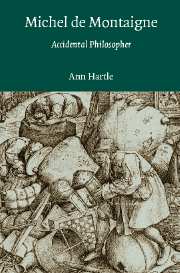Book contents
- Frontmatter
- Contents
- Acknowledgments
- Note on the Texts
- Introduction
- PART I A NEW FIGURE
- 1 “That Is Where He Got It!”: Montaigne's Caprices and the Humors of Ancient Philosophy
- 2 Bending and Stretching the Categories of Traditional Metaphysics
- 3 The Essay as Philosophical Form
- PART II ACCIDENTAL PHILOSOPHY
- PART III THE CHARACTER OF THE ACCIDENTAL PHILOSOPHER
- Notes
- Works Cited
- Index
1 - “That Is Where He Got It!”: Montaigne's Caprices and the Humors of Ancient Philosophy
Published online by Cambridge University Press: 23 July 2009
- Frontmatter
- Contents
- Acknowledgments
- Note on the Texts
- Introduction
- PART I A NEW FIGURE
- 1 “That Is Where He Got It!”: Montaigne's Caprices and the Humors of Ancient Philosophy
- 2 Bending and Stretching the Categories of Traditional Metaphysics
- 3 The Essay as Philosophical Form
- PART II ACCIDENTAL PHILOSOPHY
- PART III THE CHARACTER OF THE ACCIDENTAL PHILOSOPHER
- Notes
- Works Cited
- Index
Summary
Montaigne is surprised by himself. While making his collection of the “asinine stupidities,” the absurdities and whims of the ancient philosophers, he comes upon himself quite by accident. “So I let fly my caprices all the more freely in public, inasmuch as, although they are born with me and without a model, I know that they will find their relation to some ancient humor; and someone will not fail to say: ‘That is where he got it!’” (VS546; F409). He will appear to others as the mere collector of the opinions of the ancients, the consummate borrower, dragging out the most obscure quotations from the storehouse of his prodigious memory. But here is the moment of self-knowledge: “A new figure: an unpremeditated and accidental philosopher!”
Montaigne, of course, was entirely correct. He invented the form of the essay, and his literary genius has never been in question. But, from the point of view of philosophy, the tendency has been to place him within one or another or some combination of the ancient schools. The essay form itself, as Montaigne anticipated, does make it difficult to identify his distinct philosophical voice.
Readers of Montaigne are familiar with Pierre Villey's view that Montaigne's thought developed through three stages, roughly corresponding to the three books of essays: an early “Stoical” period, a skeptical crisis, and a final period in which Montaigne's design is to portray himself.
- Type
- Chapter
- Information
- Michel de MontaigneAccidental Philosopher, pp. 11 - 38Publisher: Cambridge University PressPrint publication year: 2003

